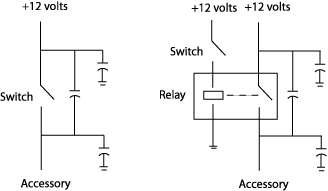Taking this off the G35 forum where i frequent. If any of you guys are on any import boards, one of the most common mods you'll see are these grounding kits. Basically it's a snake-mess of wires on the engine designed to improve grounding. These kits are the source of heated debates as to if they work or not. Some even claim to have dyno slips proving 5HP gains because of it. If you are wondering what I am talking about..here ya go

Anyway, i know stangnet has more technically knowledgable people here, so i figure i open this concept up to discussion here. If someone cares to explain how a wire from the intake manifold to the timing cover increased HP...i'm all ears.
Anyway, for a more serious discussion, how would this apply to our mustangs. They are much more simple electrically, but i'd think they would benefit from some ground improvements (nothing like the photo however)
If you are into audio, you are familiar to what is known as the Big 3. This involves heavy gauge wire from Engine block to Battery neg, alternator positive to batt positive and chassis to batt neg.
Most stangers with a 3G alt already have a heavy duty alt wire running to the pos solenoid. And i would hope some have replaced those frayed negative batt cables with good clean new cables and clean grounding spots on the engine block.
That leaves chassis ground, from which I can see if just a tiny 10 or 8ga wire next to the battery and a braided aluminum engine strap ground. Can these be improved at all? Can you remove the braided engine ground (to reduce grounding loop possibilities) and use a nice 4ga or 2ga copper cable with a solid engine and chassis connection?
I'm sure making sure the neg to block ground is good and solid might make a difference. One might be tempted to try to measure resistance from all 8 spark plugs to the neg battery terminal before and after a new neg cable to see if any improvements are made.
Is these anything beyond this that would make an improvement to suggest a rats nest of grounds like the above would give even a moderate gain? And if there are gains to be had, wouldn't that indicate poor oem grounding conditions and the need to address cleaning all electrical and chassis grounds?
Most electrical sensors on the engine (except for the temp sensor and spark plugs) feature an independant ground that is tied into the chassis wiring, so i would assume chassis grounding to be key.
Anyway, i know stangnet has more technically knowledgable people here, so i figure i open this concept up to discussion here. If someone cares to explain how a wire from the intake manifold to the timing cover increased HP...i'm all ears.
Anyway, for a more serious discussion, how would this apply to our mustangs. They are much more simple electrically, but i'd think they would benefit from some ground improvements (nothing like the photo however)
If you are into audio, you are familiar to what is known as the Big 3. This involves heavy gauge wire from Engine block to Battery neg, alternator positive to batt positive and chassis to batt neg.
Most stangers with a 3G alt already have a heavy duty alt wire running to the pos solenoid. And i would hope some have replaced those frayed negative batt cables with good clean new cables and clean grounding spots on the engine block.
That leaves chassis ground, from which I can see if just a tiny 10 or 8ga wire next to the battery and a braided aluminum engine strap ground. Can these be improved at all? Can you remove the braided engine ground (to reduce grounding loop possibilities) and use a nice 4ga or 2ga copper cable with a solid engine and chassis connection?

I'm sure making sure the neg to block ground is good and solid might make a difference. One might be tempted to try to measure resistance from all 8 spark plugs to the neg battery terminal before and after a new neg cable to see if any improvements are made.

Is these anything beyond this that would make an improvement to suggest a rats nest of grounds like the above would give even a moderate gain? And if there are gains to be had, wouldn't that indicate poor oem grounding conditions and the need to address cleaning all electrical and chassis grounds?
Most electrical sensors on the engine (except for the temp sensor and spark plugs) feature an independant ground that is tied into the chassis wiring, so i would assume chassis grounding to be key.





